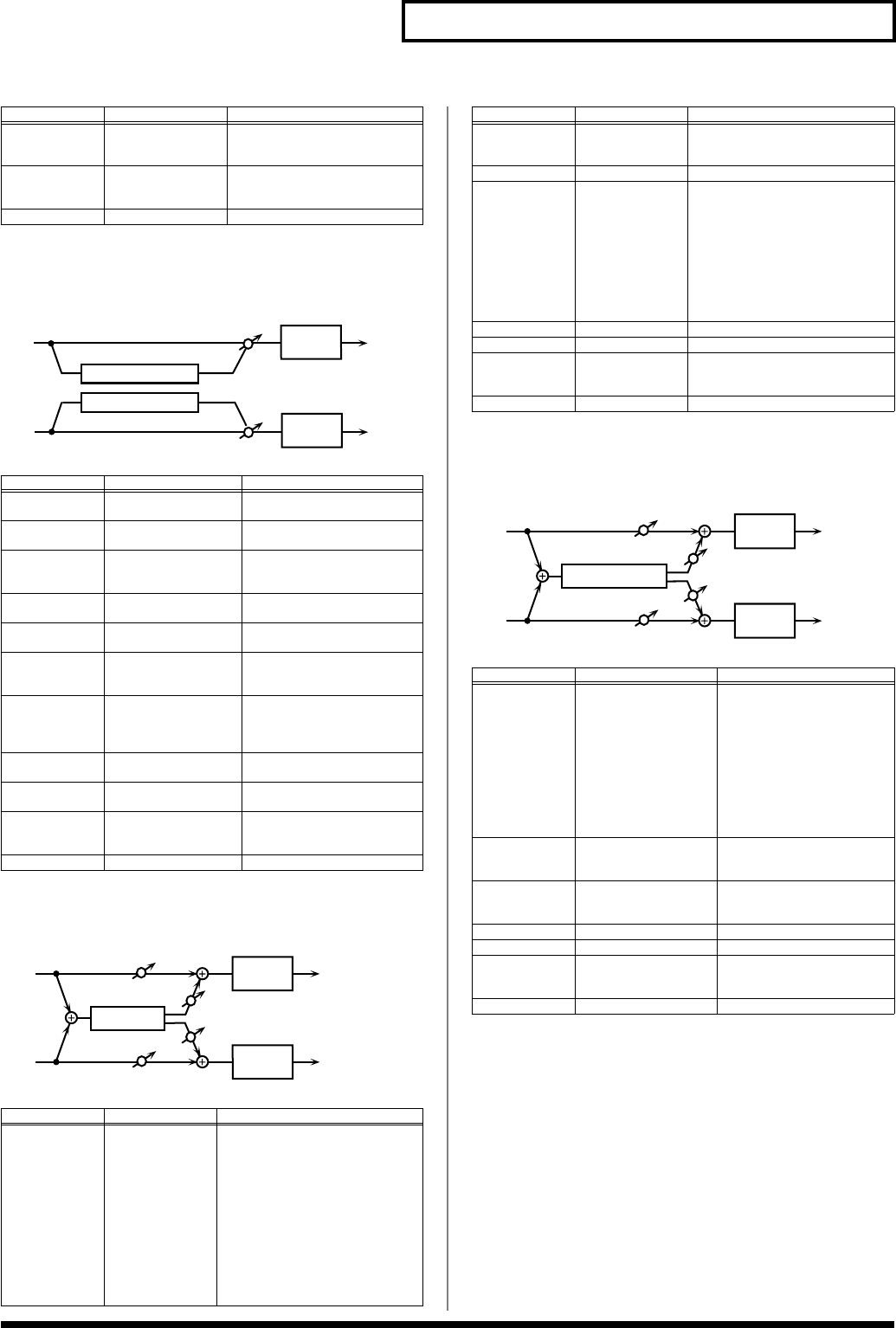
149
Adding Effects
63: STEP PITCH SHIFTER
A pitch shifter in which the amount of pitch shift is varied by a 16-
step sequence.
fig.MFX-63
64: REVERB
Adds reverberation to the sound, simulating an acoustic space.
fig.MFX-64
65: GATED REVERB
This is a special type of reverb in which the reverberant sound is cut
off before its natural length.
fig.MFX-65
Level Balance
A100:0B-A0:100B Volume balance between the
Pitch Shift 1 and Pitch Shift 2
sounds
Balance D100:0W-D0:100W Volume balance between the di-
rect sound (D) and the pitch
shifted sound (W)
Level 0-127 Output Level
Parameter
Value Explanation
Step 01–16
-24–+12 semi Amount of pitch shift at each
step (semitone units)
Rate # 0.05–10.00 Hz, note Rate at which the 16-step se-
quence will cycle
Attack # 0–127 Speed at which the amount of
pitch shift changes between
steps
Gate Time # 0–127 Duration of the pitch shifted
sound at each step
Fine -100– +100 cent Pitch shift adjustment for all
steps (2-cent units)
Delay Time 0–1300 ms, note Delay time from the original
sound until the pitch-shifted
sound is heard
Feedback # -98– +98% Proportion of the pitch-shift-
ed sound that is to be returned
to the input (negative values
invert the phase)
Low Gain -15– +15 dB Amount of boost/cut for the
low-frequency range
High Gain -15– +15 dB Amount of boost/cut for the
high-frequency range
Balance # D100:0W–D0:100W Volume balance of the origi-
nal sound (D) and pitch-shift-
ed sound (W)
Level 0–127 Output volume
Parameter Value Explanation
Type
ROOM1,
ROOM2,
STAGE1,
STAGE2,
HALL1, HALL2
Type of reverb
ROOM1:
dense reverb with
short decay
ROOM2:
sparse reverb with
short decay
STAGE1:
reverb with greater
late reverberation
STAGE2:
reverb with strong
early reflections
HALL1:
reverb with clear rever-
berance
HALL2:
reverb with rich rever-
berance
Parameter Value Explanation
L in
R in
Step Pitch Shifter
Step Pitch Shifter
L out
R out
2-Band
EQ
2-Band
EQ
L in
R in
L out
R out
Reverb
2-Band
EQ
Balance W
Balance W
Balance D
Balance D
2-Band
EQ
Pre Delay
0.0–100.0 ms Adjusts the delay time from the di-
rect sound until the reverb sound
is heard.
Time # 0–127 Time length of reverberation
HF Damp 200–8000 Hz,
BYPASS
Adjusts the frequency above
which the reverberant sound will
be cut.
As the frequency is set lower,
more of the high frequencies
will be cut, resulting in a softer
and more muted reverberance.
If you do not want to cut the
high frequencies, set this pa-
rameter to BYPASS.
Low Gain -15– +15 dB Gain of the low range
High Gain -15– +15 dB Gain of the high range
Balance # D100:0W–
D0:100W
Volume balance between the direct
sound (D) and the reverb sound
(W)
Level 0–127 Output Level
Parameter
Value Explanation
Type NORMAL, REVERSE,
SWEEP1, SWEEP2
Type of reverb
NORMAL:
conventional
gated reverb
REVERSE:
backwards re-
verb
SWEEP1:
the reverberant
sound moves from right to
left
SWEEP2:
the reverberant
sound moves from left to
right
Pre Delay 0.0–100.0 ms Adjusts the delay time from
the direct sound until the re-
verb sound is heard.
Gate Time 5–500 ms Adjusts the time from when
the reverb is heard until it
disappears.
Low Gain -15– +15 dB Gain of the low range
High Gain -15– +15 dB Gain of the high range
Balance # D100:0W–D0:100W Volume balance between the
direct sound (D) and the re-
verb sound (W)
Level # 0–127 Output Level
Parameter Value Explanation
L in
R in
L out
R out
Gated Reverb
2-Band
EQ
Balance W
Balance W
Balance D
Balance D
2-Band
EQ
JUNO-G_e.book 149 ページ 2006年2月13日 月曜日 午後2時44分


















